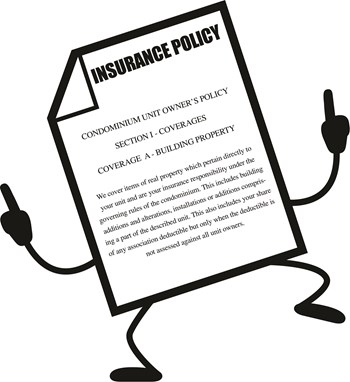
As any manager, board president or building administrator rightly knows, protecting your building community against a man-made catastrophe, natural disaster, act of God, or just basic negligence, is not a trivial task.
Property casualty insurance is a basic necessity of life, whether you manage or run a community association, live in one, or walk by one every day as you head to your job in the big city.
Rainy days occur more often than anyone would like, but by allocating resources in a prudent manner, a board or community association can minimize its losses while advocating the best interests of its management professionals, unit owners and shareholders.
The Basics
It may sound simplistic. But let's start at the beginning: What exactly is insurance? And what types are must-haves for any board or association? Loretta Worters, vice president of communications at the Insurance Information Institute (I.I.I.), a national resource organization for the property casualty industry, details the basic coverages as these three items.
1. General Liability - Because the association bears much of the responsibility for maintaining the building and property, it faces significant liability exposure for injuries and damages that occur on the premises. Thus general liability insurance is particularly important to have if you have a swimming pool or other high-risk amenities located therein. If someone is injured or the property is damaged as a result of negligence of the association, leadership, management or maintenance staff, the general liability coverage will pay for any judgments or settlements (up to the policy limits). Building administrators and insurance professionals should make sure that there is adequate liability limits commensurate with the risk inherent with an individual amenity. The general liability coverage will also pay for the cost to defend the association itself, but not its directors or officers. How much you should have depends on many factors including size of the building and types of exposures (pool, tennis court, etc.).
2. Directors & Officers Liability - This protects the association against lawsuits arising from injuries and property damage. It also protects against suits relating to errors in decision-making by the board, like in a case of mismanaged funds.
3. Fidelity Coverage - This protects the association in the case that anyone absconds with reserve funds, accounts payables, or any income, checks or cash received by the board or association. Reserves are accumulated to ensure that there is enough long-term revenue to pay for major capital improvements for the building, such as a roof. Maintenance and repairs need to be done in a timely, sometimes urgent basis, so if an association's funds have been misappropriated, that could result in significant assessments to owners. Fidelity coverage is typically used to reimburse any embezzled funds or misappropriations.
Add-ons: Good to Have
While being aware of the various insurance options into which your association should look is certainly important, it's by no means the extent of the battle. A board must carefully ponder exactly how much of its finances it should allocate toward a policy, assessing all of the variables at play, including the size of the association, the number of units, reserve capital, likelihood of an accident, etc. Also, insurance isn't a one-time purchase. So a board must be aware as to when, why and how often it should reevaluate its coverage.
A board must find that happy medium between indemnifying itself and not breaking the bank. "In any financial advisory role, the question arises as to what level insurance is required and how much you should buy," explains Tom Neis, president of Neis Insurance Agency in Crystal Lake, Illinois. "It's partially determined by the number of units at your property, but it's also determined by litigation. I personally suppose that I wouldn't sit on a board unless it had at least $2 million to $5 million dollars for protection against any mistake or perceived mistake that a director might make, like, say they bring in a roofing contractor to re-do the association roof, they opt for the low-cost bid, and it causes them nothing but trouble with leaks and what-not."
It's also important to see that your treasurer is appropriately bonded. "Bonding isn't that costly," says Neis. "Let's say that bonding for $250,000 in your association's checkbook costs $500. I'd make sure that the association had at least the state minimum, and I'd probably go over the top. I wouldn't err toward just having directors & officers insurance; I'd make sure that the treasurer is bonded such that the board isn't held liable in the case that it didn't place definitive enough guidelines as to how and where money is spent."
Associations are often focused on penny-pinching, so it helps to frame an insurance purchase in terms of what you may be saving down the line, as opposed to what you're spending now. "A board can buy an inexpensive $200 or $300 D&O policy," notes Sean Daly, CPCU, with Affiliated Insurance Managers in Warwick, Rhode Island. "But it's much more prudent to spend an extra few hundred and get the real policy that automatically includes the association manager as an insured, and gives you full prior acts. You're spending several hundred more upfront, sure, but you're potentially protecting yourself from losing literal millions down the line."
The imperative thing is that a board not be dazzled by the lowest price. "More often than not, boards gravitate towards a bargain, and depend on the seller to tell them what's covered and isn't," says Richard Resnick, a senior account executive with Schechner Lifson Corporation in Summit, New Jersey. "Oftentimes, though, a seller sells the board rather than educating them. Only when a board knows precisely what it's buying can it make an informed decision."
Exclusions
Different amenities can carry with them a varying degree of risk, and can affect insurance rates accordingly.
"In an application for insurance, and in an inspection by the insurance company, the insurer will look at all the amenities, and ask various questions along the lines of 'is there a pool? Does the pool have a lifeguard? Is there a diving board? How about a clubhouse? If so, can you bring guests? Will there be alcohol on the premises?, etc.'" says Resnick. "And this refines the exposure that the underwriter has."
The association has the option to bring in an outside appraiser to ensure that a potential insurer is assessing an adequate value to each amenity. "It's a very common thing today to have a variance as to what an amenity is actually worth," says Neis. "From an insurance standpoint, it's not what an association paid for an amenity, or what the association thinks that amenity is worth; it's how much that amenity will cost to rebuild. And those estimates can be off by as much as 50%. Usually, the association will try to argue down how much something is worth, while the insurance company will try to argue up the value. In all likelihood, an association may be unaware as to how expensive something will be to rebuild."
Rental Issues
In a scenario wherein an owner rents their unit to another individual, there are insurance complications that need be addressed.
"Let's say that you own a unit and rent it to me," suggests Paul Kaliades, president of Renters Legal Liability, LLC, in Salt Lake City, Utah, which has a product called Condominium Legal Liability, a property damage loss waiver that protects community associations, owners and residents from losses caused by damages originated by owners and residents.
"If I cause a $25,000 kitchen fire, unfortunately, your HO-6 community association owner's insurance policy won't cover that loss, as you have invalidated the policy by engaging in a commercial endeavor and renting it to me. And this can get extreme. Even when there are renting restrictions in the bylaws, they aren't always heavily policed by the board. So we've seen some dramatic problems come up in mid-rise or high-rise buildings, where you have a flood in a unit that seeps into four or five neighboring units, such that you're talking a $75,000 or $100,000 repair bill. Without protection in place for the renter, you're in trouble."
So it's imperative that a board be aware of the activities and conduct enacted by the individual owners within the property. If renting or subletting is taking place, and all involved parties don't do their due diligence in regard to insurance, everyone involved could face steep penalties in the event of an accident.
Ch-ch-changes
Amenities are added or removed, new units are constructed, the facade is altered, residential properties are constantly in flux, and thus may require adjustments to the association's insurance coverage.
"Every year, I present to my clients a proposal with a summary of their coverages," says Daly. "And every few years, they may want to compare prices with other insurance companies. If an association is particularly antsy regarding insurance charges or what they pay for reinsurance, we'll even do comparative shopping annually. But at the very least, it's always good to do a quick yearly sit-down or a thorough reading-through of your coverage policy. And if there's construction going on, any relevant effect on insurance warrants more attention."
But Neis warns against overdoing it in regard to bargain shopping: "The worst case example of prudent directorship is if they go out and price their insurance every year. The problem therein is, when you've jumped around too much, and then you have that one catastrophe, the carrier is likely to cancel you going forward. It's better to have a long-term relationship with a carrier, as long as you know that the pricing is fair and equitable—and how one determines that is admittedly a good question. I'd rather have a long-term carrier with which I can negotiate inspections and replacement analysis reports to make sure that I'm covered properly; that to me is the prudence of a directorship, rather than going out and getting a price every year. If you do that, I imagine you'll be caught short, because the pricing on most associations has very much been compressed over the past five or six years. Thus you're not likely to save money by jumping around."
Finally, Resnick hammers home the importance of transparency when dealing with an insurance provider: "Misrepresent anything in your application, shame on you. Because you're buying insurance so that, should you need it, it responds the way that it's supposed to. If the carrier sees that you misrepresented, they have grounds to decline the claim based on false information. However, if you didn't falsify anything, and they provided the policy, you have grounds to sue in terms of what they'd said they'd insure you for. So always tell the insurance provider the gospel. And if you don't know the answer, be upfront about that."




Leave a Comment